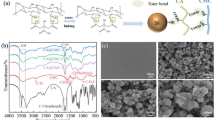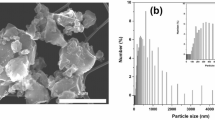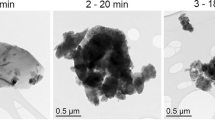Abstract
A new binder, poly(2-propenoic acid, 2-methyl-, 3-[(2-aminoethyl) amino]-2-hydroxypropyl ester) (P-HAEAPMA), is synthesized and applied to silicon/graphite (Si/graphite) anodes in lithium-ion batteries. The Si/graphite anode with the binder exhibits good electrochemical stability. Furthermore, the materials on the discarded Si/graphite/P-HAEAPMA electrode can be recycled for use based on water because the P-HAEAPMA binder is easily soluble in water. The discharge capacity and capacity retention rate of the electrode with reused materials are slightly lower than those of the original Si/graphite/P-HAEAPMA electrode. The binder is rich in polar amino and hydroxyl groups, which not only helps to form strong adhesion between the electrode active material and copper foil but also promotes the transport of Li ions. The electrochemical performance of the electrode with the P-HAEAPMA binder is significantly enhanced compared with that of the electrode with the traditional PVDF binder or water-based LA133 binder. After 305 cycles, a specific capacity of 485.0 mA h g−1 and a capacity retention rate of 74.8% are achieved for the Si/graphite/P-HAEAPMA electrode.
This is a preview of subscription content, access via your institution
Access options
Subscribe to this journal
Receive 12 print issues and online access
$259.00 per year
only $21.58 per issue
Buy this article
- Purchase on Springer Link
- Instant access to full article PDF
Prices may be subject to local taxes which are calculated during checkout










Similar content being viewed by others
References
Munaoka T, Yan X, Lopez J, To JWF, Park J, Tok JBH, et al. Ionically conductive self-healing binder for low cost Si microparticles anodes in Li-ion batteries. Adv Energy Mater. 2018;8:1703138–49.
Huang Q, Wan C, Loveridge M, Bhagat R. Partially neutralized polyacrylic acid/poly(vinyl alcohol) blends as effective binders for high-performance silicon anodes in lithium-ion batteries. ACS Appl Energy Mater. 2018;1:6890–98.
Salem N, Lavrisa M, Abu-Lebdeh Y. Ionically-functionalized poly(thiophene) conductive polymers as binders for silicon and graphite anodes for Li-ion batteries. Energy Technol. 2016;4:331–40.
Wang X, Li G, Seo MH, Lui G, Hassan FM, Feng K, et al. Carbon-coated silicon nanowires on carbon fabric as self-supported electrodes for flexible lithium-ion batteries. ACS Appl Mater Interfaces. 2017;9:9551–58.
Chen SQ, Shen LF, van Aken PA, Maier J, Yu Y. Dual-functionalized double carbon shells coated silicon nanoparticles for high performance lithium-ion batteries. Adv Mater. 2017;29:1605650–57.
Agyeman DA, Song K, Lee G-H, Park M, Kang Y-M. Carbon-coated Si nanoparticles anchored between reduced graphene oxides as an extremely reversible anode material for high energy-density Li-Ion battery. Adv Energy Mater. 2016;6:1600904–13.
Ryu J, Hong D, Choi S, Park S. Synthesis of ultrathin Si nanosheets from natural clays for lithium-ion battery anodes. ACS Nano. 2016;10:2843–51.
Shin D, Park H, Paik U. Cross-linked poly(acrylic acid)-carboxymethyl cellulose and styrene-butadiene rubber as an efficient binder system and its physicochemical effects on a high energy density graphite anode for Li-ion batteries. Electrochem Commun. 2017;77:103–06.
Zhu JX, Feng C. International conference on computational problem-solving, ICCP 2012; 2012:440–41.
Mazouzi D, Lestriez B, Roue L, Guyomard D. Silicon composite electrode with high capacity and long cycle life. electrochem. Solid-State Lett. 2009;12:A215–18.
Liu D, Zhao Y, Tan R, Tian L-L, Liu Y, Chen H, et al. Novel conductive binder for high-performance silicon anodes in lithium ion batteries. Nano Energy. 2017;36:206–12.
Wei L, Hou Z. High performance polymer binders inspired by chemical finishing of textiles for silicon anodes in lithium ion batteries. J Mater Chem A. 2017;5:22156–62.
Song J, Zhou M, Yi R, Xu T, Gordin ML, Tang D, et al. Interpenetrated gel polymer binder for high-performance silicon anodes in lithium-ion batteries. Adv Funct Mater. 2014;24:5904–10.
Ye Q, Zheng P, Ao X, Yao D, Lei Z, Deng Y, et al. Novel multi-block conductive binder with polybutadiene for Si anodes in lithium-ion batteries. Electrochim Acta. 2019;315:58–66.
Zeng W, Wang L, Peng X, Liu T, Jiang Y, Qin F, et al. Enhanced ion conductivity in conducting polymer binder for high-performance silicon anodes in advanced lithium-ion batteries. Adv Energy Mater. 2018;8:1702314–21.
Ho KP, R. S. W., Shen PH. Method for recycling lithium-ion battery. GRST International Limited. CN. 109478698 A; 2019;1–51.
Liu J, Zhang Q, Zhang T, Li JT, Huang L, Sun SG. A robust ion-conductive biopolymer as a binder for si anodes of lithium-ion batteries. Adv Funct Mater. 2015;25:3599–605.
Liu Z, He X, Fang C, Camacho‐Forero LE, Zhao Y, Fu Y, et al. Reversible crosslinked polymer binder for recyclable lithium sulfur batteries with high performance. Adv Funct Mater. 2020;30:2003605–14.
Qi Y, Meng F, Yi X, Shu J, Chen M, Sun Z, et al. A novel and efficient ammonia leaching method for recycling waste lithium ion batteries. J Clean Prod. 2020;251:119665–73.
Li J, Lu Y, Yang T, Ge D, Wood DL 3rd, Li Z. Water-based electrode manufacturing and direct recycling of lithium-ion battery electrodes-a green and sustainable manufacturing system. iScience. 2020;23:101081–88.
Li J-T, Wu Z-Y, Lu Y-Q, Zhou Y, Huang Q-S, Huang L, et al. Water soluble binder, an electrochemical performance booster for electrode materials with high energy density. Adv Energy Mater. 2017;7:1701185–214.
Salini PS, Gopinadh SV, Kalpakasseri A, John B, Thelakkattu Devassy M. Toward greener and sustainable Li-ion cells: an overview of aqueous-based binder systems. ACS Sustain Chem Eng. 2020;8:4003–25.
Drofenik J, Gaberscek M, Dominko R, Poulsen FW, Mogensen M, Pejovnik S. et al. Cellulose as a binding material in graphitic anodes for Li ion batteries: a performance and degradation study. Electrochim Acta. 2003;48:883–89.
Yue L, Zhang L, Zhong H. Carboxymethyl chitosan: a new water soluble binder for Si anode of Li-ion batteries. J Power Sources. 2014;247:327–31.
Kuruba R, Datta MK, Damodaran K, Jampani PH, Gattu B, Patel PP, et al. Guar gum: structural and electrochemical characterization of natural polymer based binder for silicon–carbon composite rechargeable Li-ion battery anodes. J Power Sources. 2015;298:331–40.
Chandrasiri K, Jayawardana M, Abeywardana MY, Kim J, Lucht BL. Casein from Bovine milk as a binder for silicon based electrodes. J Electrochem Soc. 2019;166:A4115–21.
Wang Y-X, Xu Y, Meng Q, Chou S-L, Ma J, Kang Y-M, et al. Chemically bonded Sn nanoparticles using the crosslinked epoxy binder for high energy-density Li ion battery. Adv Mater Interfaces. 2016;3:1600662–68.
Lin C-T, Huang T-Y, Huang J-J, Wu N-L, Leung M-K. Multifunctional co-poly(amic acid): a new binder for Si-based micro-composite anode of lithium- ion battery. J Power Sources. 2016;330:246–52.
Ye H, Lei D, Shen L, Ni B, Li B, Kang F, et al. In-situ polymerized cross-linked binder for cathode in lithium-sulfur batteries. Chin Chem Lett. 2020;31:570–74.
Li JL, Xiang MW, Wang Y, Wu JH, Zhao H, Liu H. Effects of adhesives on the electrochemical performance of monodisperse LiMn0.8Fe0.2PO4/C microspheres as cathode materials for high power lithium- ion batteries. J Mater Chem A. 2017;5:7952–60.
Li J, Guo Z, Xin J, Zhao G, Xiao H. 21-Arm star polymers with different cationic groups based on cyclodextrin core for DNA delivery. Carbohydr Polym. 2010;79:277–83.
Shen HY, Sun MN, Hu MQ, Cheng JJ. Design and controllable synthesis of ethylenediamine-grafted ion imprinted magnetic polymers for highly selective adsorption to perchlorate. RSC Adv. 2018;8:29928–38.
Su M, Liu S, Wan H, Dou A, Liu K, Liu Y. Effect of binders on performance of Si/C composite as anode for Li-ion batteries. Ionics. 2018;25:2103–09.
Wang R, Feng L, Yang W, Zhang Y, Zhang Y, Bai W, et al. Effect of different binders on the electrochemical performance of metal oxide anode for lithium-ion batteries. Nanoscale Res Lett. 2017;12:575–85.
Wang W, Yue X, Meng J, Wang X, Zhou Y, Wang Q, et al. Comparative study of water-based LA133 and CMC/SBR binders for sulfur cathode in advanced lithium–sulfur batteries. J Phys Chem C. 2018;123:250–57.
Chen C, Lee SH, Cho M, Kim J, Lee Y. Cross-linked chitosan as an efficient binder for si anode of li-ion batteries. ACS Appl Mater Interfaces. 2016;8:2658–65.
Hapuarachchi SNS, Wasalathilake KC, Nerkar JY, Jaatinen E, O’Mullane AP, Yan C. Mechanically robust tapioca starch composite binder with improved ionic conductivity for sustainable lithium-ion batteries. ACS Sustain Chem Eng. 2020;8:9857–65.
Jiang Y, Mu D, Chen S, Wu B, Cheng K, Li L, et al. Electrochemical performance of Si anode modified with carbonized gelatin binder. J Power Sources. 2016;325:630–36.
Gao Y, Qiu X, Wang X, Gu A, Zhang L, Chen X, et al. Chitosan-g-poly(acrylic acid) copolymer and its sodium salt as stabilized aqueous binders for silicon anodes in lithium-ion batteries. ACS Sustain Chem Eng. 2019;7:16274–83.
Tanaka R, Sakurai M, Sekiguchi H, Mori H, Murayama T, Ooyama T. Lithium ion conductivity in polyoxyethylene/polyethylenimine blends. Electrochim Acta. 2001;46:1709–15.
Zhao L, Sun Z, Zhang H, Li Y, Mo Y, Yu F, et al. An environment-friendly crosslinked binder endowing LiFePO4 electrode with structural integrity and long cycle life performance. RSC Adv. 2020;10:29362–72.
Nam J, Kim E, K KR, Kim Y, Kim TH. A conductive self healing polymeric binder using hydrogen bonding for Si anodes in lithium ion batteries. Sci Rep. 2020;10:14966–77.
Wu C-Y, Duh J-G. Ionic network for aqueous-polymer binders to enhance the electrochemical performance of Li-Ion batteries. Electrochim Acta. 2019;294:22–27.
Zhang Z, Zeng T, Lai Y, Jia M, Li J. A comparative study of different binders and their effects on electrochemical properties of LiMn2O4 cathode in lithium ion batteries. J Power Sources. 2014;247:1–8.
Isozumi H, Horiba T, Kubota K, Hida K, Matsuyama T, Yasuno S, et al. Application of modified styrene-butadiene-rubber-based latex binder to high-voltage operating LiCoO2 composite electrodes for lithium-ion batteries. J Power Sources. 2020;468:228332–41.
Liu Y, Tai Z, Zhou T, Sencadas V, Zhang J, Zhang L, et al. An all-integrated anode via interlinked chemical bonding between double-shelled-yolk-structured silicon and binder for lithium-ion batteries. Adv Mater. 2017;29:1703028–38.
Tong J, Han C, Hao X, Qin X, Li B. Conductive polyacrylic acid-polyaniline as a multifunctional binder for stable organic quinone electrodes of lithium-ion batteries. ACS Appl Mater Interfaces. 2020;12:39630–38.
Wu X, Luo C, Du L, Xiao Y, Li S, Wang J, et al. Exploiting pulping waste as an ecofriendly multifunctional binder for lithium sulfur batteries. ACS Sustain Chem Eng. 2019;7:8413–18.
Yu L, Liu J, He S, Huang C, Gan L, Gong Z, et al. A novel high-performance 3D polymer binder for silicon anode in lithium-ion batteries. J Phys Chem Solids. 2019;135:109113–19.
Mochizuki T, Aoki S, Horiba T, Schulz-Dobrick M, Han Z-J, Fukuyama S, et al. “Natto” binder of poly-γ-glutamate enabling to enhance silicon/graphite composite electrode performance for lithium-ion batteries. ACS Sustain Chem Eng. 2017;5:6343–55.
Acknowledgements
The authors thank that this work was supported by the Key Research Program of the Chinese Academy of Sciences, Grant No. ZDRW-CN-2016-1.
Author information
Authors and Affiliations
Corresponding author
Ethics declarations
Conflict of interest
The authors declare no competing interests.
Additional information
Publisher’s note Springer Nature remains neutral with regard to jurisdictional claims in published maps and institutional affiliations.
Supplementary information
Rights and permissions
About this article
Cite this article
Yu, LM., Luo, Z., Gong, CR. et al. Water-based binder with easy reuse characteristics for silicon/graphite anodes in lithium-ion batteries. Polym J 53, 923–935 (2021). https://doi.org/10.1038/s41428-021-00486-y
Received:
Revised:
Accepted:
Published:
Issue Date:
DOI: https://doi.org/10.1038/s41428-021-00486-y



